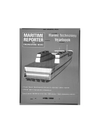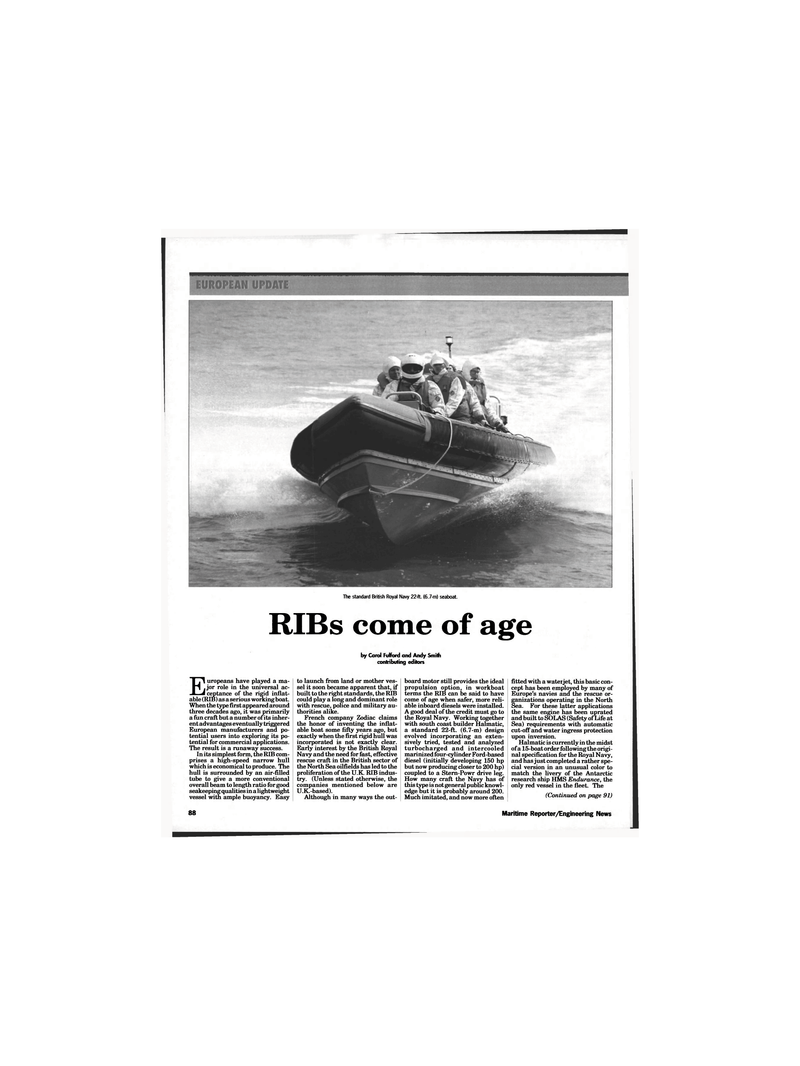
Page 74: of Maritime Reporter Magazine (April 1995)
Read this page in Pdf, Flash or Html5 edition of April 1995 Maritime Reporter Magazine
The standard British Royal Navy 22-ft. (6.7-m) seaboat.
RIBs come of age by Carol Futford and Andy Smith contributing editors
Europeans have played a ma-jor role in the universal ac-ceptance of the rigid inflat- able (RIB) as a serious working boat.
When the type first appeared around three decades ago, it was primarily a fun craft but a number of its inher- ent advantages eventually triggered
European manufacturers and po- tential users into exploring its po- tential for commercial applications.
The result is a runaway success.
In its simplest form, the RIB com- prises a high-speed narrow hull which is economical to produce. The hull is surrounded by an air-filled tube to give a more conventional overall beam to length ratio for good seakeeping qualities in a lightweight vessel with ample buoyancy. Easy to launch from land or mother ves- sel it soon became apparent that, if built to the right standards, the RIB could play a long and dominant role with rescue, police and military au- thorities alike.
French company Zodiac claims the honor of inventing the inflat- able boat some fifty years ago, but exactly when the first rigid hull was incorporated is not exactly clear.
Early interest by the British Royal
Navy and the need for fast, effective rescue craft in the British sector of the North Sea oilfields has led to the proliferation of the U.K. RIB indus- try. (Unless stated otherwise, the companies mentioned below are
U.K.-based).
Although in many ways the out- board motor still provides the ideal propulsion option, in workboat terms the RIB can be said to have come of age when safer, more reli- able inboard diesels were installed.
A good deal of the credit must go to the Royal Navy. Working together with south coast builder Halmatic, a standard 22-ft. (6.7-m) design evolved incorporating an exten- sively tried, tested and analyzed turbocharged and intercooled marinized four-cylinder Ford-based diesel (initially developing 150 hp but now producing closer to 200 hp) coupled to a Stern-Powr drive leg.
How many craft the Navy has of this type is not general public knowl- edge but it is probably around 200.
Much imitated, and now more often fitted with a waterjet, this basic con- cept has been employed by many of
Europe's navies and the rescue or- ganizations operating in the North
Sea. For these latter applications the same engine has been uprated and built to SOLAS (Safety of Life at
Sea) requirements with automatic cut-off and water ingress protection upon inversion.
Halmatic is currently in the midst of a 15-boat order following the origi- nal specification for the Royal Navy, and has just completed a rather spe- cial version in an unusual color to match the livery of the Antarctic research ship HMS Endurance, the only red vessel in the fleet. The (Continued on page 91) 88 Maritime Reporter/Engineering News

 73
73

 75
75
